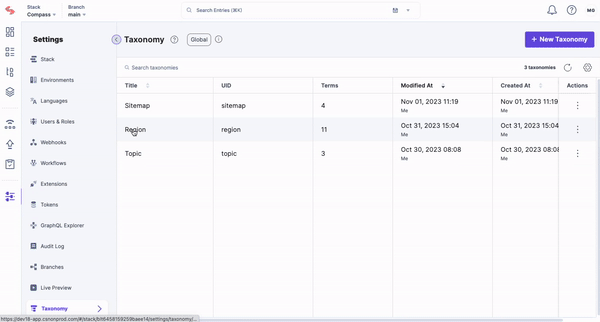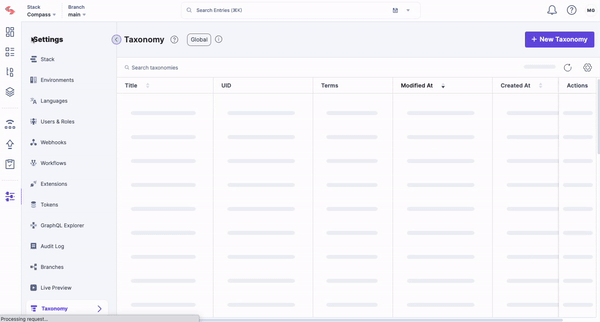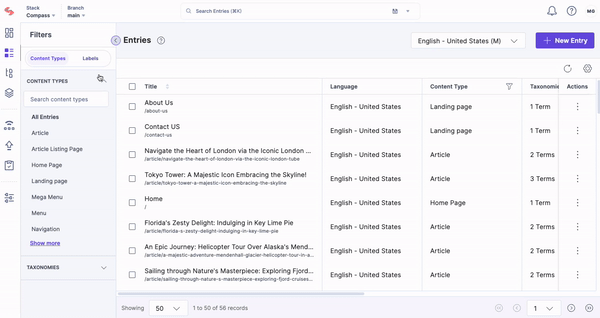Introducing Taxonomy: Establish scalable content best practices with control and ease

The power of advanced taxonomy
In today's fast-paced digital landscape, effective content organization and collaboration are crucial for businesses to stay competitive. While a headless content management system (CMS) offers increased flexibility and adaptability compared to legacy systems, it lacks the inherent structure that a legacy CMS provides.
That's where Taxonomy comes in. Incorporating a taxonomy feature that integrates hierarchical structures and metadata elements capitalizes on the market demand for a more robust and well-rounded content management solution. This robust feature aims to streamline content management, enhance collaboration, and improve overall productivity at scale. The arrival of Taxonomy helps our customers scale content organization and role-based permissions, enabling users to manage large and complex data structures with ease while maintaining content security and separation. This innovative approach differentiates the Contentstack CMS and solidifies our position as a market leader in the enterprise content management space.
What is Taxonomy?
Taxonomy enhances content organization and enables content editors, particularly from larger enterprise environments, to handle vast and complex data structures with full control and ease. Taxonomy enables multiple ways to classify, organize and manage content, tailored to your organization’s specific needs. These classification methods can be structured hierarchically, relationally (may or may not be hierarchical), or as predefined lists based on metadata/attributes that can be applied across various use cases. Although its name, Taxonomy, implies categorization by hierarchy, it can be reused and repurposed to simplify content organization and management for large content volumes.
Core features
For developers
- Create: Create new taxonomies and terms. Developers are able to create sibling terms and child terms to establish a hierarchical structure for better content organization.

Import & Export: Import one set of taxonomies and terms at a time, including nested terms, which helps save time and effort when managing a large number of taxonomies and terms.
Content modeling with taxonomies: Associate specific taxonomies with content types, allowing for better organization and management of content. Developers can add a new taxonomy field, restrict which taxonomies can be tagged, and limit an editor's tagging options to the selected taxonomies.

For business users
- List view (coming in GA): Content editors are able to view a list of all taxonomies on the Settings page, displaying relevant information such as Name, Description, Referenced Terms, Modified At, and Created At. This allows users to see an overview of their taxonomies and understand the relationship between taxonomy terms and categorized entries.

- Navigating entries with taxonomy structure: Content editors can navigate their content using a tree-like nested taxonomy structure. This will provide content editors with an intuitive way to browse, manage, and categorize their content based on the taxonomy.

Taxonomy-based search: When searching for content, content editors have two primary methods at their disposal. A basic search involves simply typing a keyword, such as ‘India’ into the search bar, which brings up all entries categorized with that term. For a more tailored approach, the advanced search option allows you to apply multiple conditions, enabling you to refine your query and get more specific results.
Key benefits
Simplified content security & ownership
Business leaders need a content ownership process that makes sense and is secure. Taxonomy helps stratify access to content within a content type by taxonomy term, without requiring a content type to be duplicated. This ensures the correct people on the team have access and permission to create and manage content most relevant to their respective project(s). No more content confusion and interruption as teams grow or change over time.
Manage large-scale content projects
Managing and organizing taxonomies of content for distinct business purposes on an aging legacy system is conducive to organizational limitations around long-term scalability and efficiency. With Taxonomy, manage and implement scalable content management processes for large-scale content projects across functions and systems with a direct line of sight.
Gain full purview of content taxonomy
Business teams need a way to effortlessly navigate to the content most relevant to their current priorities. Taxonomy helps provide navigation to content that spans multiple content types. It can mimic their site navigation structure or their own personalized ways of organizing content without having to understand the context of which content type their content lives in. With Taxonomy, manage and lead content projects from a single vantage point, giving you the confidence and assurance to execute.
What's next?
Taxonomy is a game-changer for content organization and collaboration. With its robust functionality and benefits, businesses can manage large-scale content projects, improve content security & ownership, and enhance overall content management experiences. By following best practices and leveraging the power Taxonomy, businesses can stay ahead in the digital landscape.
Please note that Taxonomy is currently in its Early Access phase, and we appreciate your participation as early adopters. If you’re interested in joining our Early Access Program, please reach out to your Customer Success Manager. Your feedback will be invaluable as we work to refine and improve Taxonomy. Our goal is to roll out Taxonomy to all users in the near future, delivering a polished and valuable addition to your Contentstack experience.
If you’re fascinated by the versatile options for classifying, organizing, and managing content, we invite you to dive into our Taxonomy documentation.
About Contentstack
The Contentstack team comprises highly skilled professionals specializing in product marketing, customer acquisition and retention, and digital marketing strategy. With extensive experience holding senior positions in notable technology companies across various sectors, they bring diverse backgrounds and deep industry knowledge to deliver impactful solutions.
Contentstack stands out in the composable DXP and Headless CMS markets with an impressive track record of 87 G2 user awards, 6 analyst recognitions, and 3 industry accolades, showcasing its robust market presence and user satisfaction.
Check out our case studies to see why industry-leading companies trust Contentstack.
Experience the power of Contentstack's award-winning platform by scheduling a demo, starting a free trial, or joining a small group demo today.
Follow Contentstack on Linkedin



.svg?format=pjpg&auto=webp)


.svg?format=pjpg&auto=webp)
.svg?format=pjpg&auto=webp)
.svg?format=pjpg&auto=webp)
.svg?format=pjpg&auto=webp)






